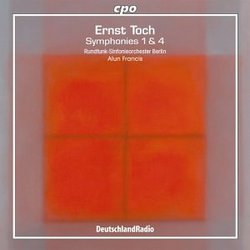| All Artists: Ernst Toch, Alun Francis, Berlin Radio Symphony Orchestra Title: Ernst Toch: Symphonies Nos. 1 & 4 Members Wishing: 0 Total Copies: 0 Label: Cpo Records Release Date: 3/16/2004 Genre: Classical Style: Symphonies Number of Discs: 1 SwapaCD Credits: 1 UPC: 761203977420 |
Search - Ernst Toch, Alun Francis, Berlin Radio Symphony Orchestra :: Ernst Toch: Symphonies Nos. 1 & 4
 | Ernst Toch, Alun Francis, Berlin Radio Symphony Orchestra Ernst Toch: Symphonies Nos. 1 & 4 Genre: Classical
|
Larger Image |
CD Details |
CD ReviewsA Master at the Height of His Powers J Scott Morrison | Middlebury VT, USA | 12/16/2004 (5 out of 5 stars) "Ernst Toch (1887-1964) came late to the symphony. He was a renowned composer, feted on several continents, before he ever took up his pen to write his first symphony, his Opus 72, finished in 1950, premièred in Vienna, and taken up shortly after by Otto Klemperer, William Steinberg and others. I had not previously known any of his symphonies beyond the No. 3 which had had a famous recording by Steinberg and the Pittsburgh Symphony back in the 1960s after it won the Pulitzer Prize. This CD completes the series of all seven symphonies and it has been a revelation. In my opinion, Toch is a major symphonist, fit to join the other giants of the century just finished.
The 40-minute First Symphony has a motto from Martin Luther: 'And if the world were full of devils.' Coming, as it did, right after the Second World War, it is not hard to imagine what this may refer to. Indeed, because of events in central Europe, Toch had been one of the first of the flood of Jewish intellectuals and artists to leave Austria in 1933, and he eventually wound up in Los Angeles. The symphony itself, however, is absolute music. None of the four movements follows the classical sonata allegro form. The first is in three loosely connected sections, roughly slow-fast-slow and has a catchy rhythmic middle section that is quoted again in the finale. The language is somewhere between Bartók and, in spots, the sardonic Shostakovich, but in a style that is not obviously either. As one comes to know Toch's entire symphonic oeuvre, it becomes apparent that he has a language all his own, sometimes tonal, sometimes polytonal, sometimes almost but never quite atonal. And all his music is highly contrapuntal; indeed he is a master of modern counterpoint, reminding one at times of Hindemith in a warmer vein. Especially so is the second movement whose main theme seems to pop up in all the voices at one time or another, often against a pizzicato background. The third movement is marked 'langsam, zart' ('slowly, tenderly') and begins with a long sinuous unaccompanied flute solo. The movement has a melancholic feel and is highly chromatic. The finale is a vigorous summing up, with several brief respites in short, tender interludes. The Fourth Symphony was dedicated to the widow of American composer Edward MacDowell. She had founded an artists' colony in New Hampshire where Toch had spent several extended stays. Between the symphony's three movements are spoken narratives, here read by the conductor, Alun Francis. Written by Toch to honor Marian MacDowell who had recently died, they are heartfelt sentiments ('thankfulness/That it was granted to me/That our paths should cross') but unnecessary after first hearing; unfortunately they are not tracked separately, but they ARE placed conveniently at the end of the Movement I and II tracks so that one can quickly move to the next movement with the flick of a button. At the symphony's première (1957, not 1947 as stated in the booklet) by Antal Dorati and the Minneapolis Symphony, the conductor refused to have the words recited, against the composer's wishes. The first movement is generally quiet and slow; it has three sections 'molto dolce,' 'molto tranquillo,' and 'molto equalmente,' and has more a serene feeling than one of mourning or sadness. The last pages of the movement repeat some aspects of the opening with its long unison violin line. The brief second movement is marked 'lively (con brio)' and begins with flute and harp colloquy, soon joined by temple blocks, and eventually becoming an almost flippant full-out but skittery scherzo. Here are some Shostakovian echoes. The finale, almost as long as the first--ten minutes--begins with a stark statement that reminds one of the kind of passacaglia theme Shostakovich wrote (as in the First Violin Concerto) to portray anguish. As it happens, however, Toch does not use this theme as a passacaglia bass, but rather as the basis of a broad and freely contrapuntal contemplation of loss and acceptance. This series comprising all the symphonies of Toch has been played by the Berlin Radio Symphony Orchestra under Alun Francis, who has apparently made a scholarly study of Toch's works. One could not ask for more committed or seamless performances. Sound is quite good. The series as a whole has been a major addition to the catalog of 20th-century symphonic works. Enthusiastically recommended. TT=66'38" Scott Morrison" |

 Track Listings (7) - Disc #1
Track Listings (7) - Disc #1